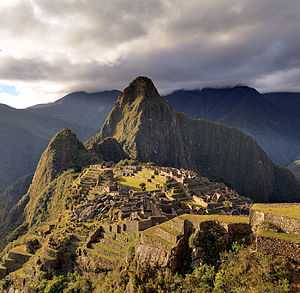Incan engineers
 |
| Inca Empire |
|---|
| Inca society |
| Education · Religion · Mythology |
| Architecture · Engineering · Roads |
| Army · Agriculture · Cuisine |
| Inca history |
| Spanish conquest of the Inca Empire |
Hydraulic engineering
The builders of Machu Picchu planned and built impressive waterworks in their city centers, including canals, fountains, drainage systems and expansive irrigation. Machu Picchu’s infrastructure and water supply system have been hailed as “the pinnacle of the architectural and engineering works of the Inca civilization”.[1] Major Incan centers were chosen by experts who decided the site, its apportionment, and the basic layout of the city.
Machu Picchu
In 1450 the best example of Incan civil engineering, Machu Picchu, was constructed. The famous lost Inca city is an architectural remnant of a society whose understanding of civil and hydraulic engineering was both advanced and complete. At 8,000 feet (2,400 m) in the Andes Mountains, the city planners had to consider the steep slopes of the site as well as the 2,000 mm of rainfall per year. Making models out of clay before beginning to build, the city planners remained consistent with Inca architecture and laid out a city that separated the agriculture and urban areas. Before construction began the engineers had to assess the spring and whether it could provide for all of the city’s anticipated citizens. After evaluating the water supply, the civil engineers designed a 2,457-foot (749 m)-long canal to what would become the city’s center.
The Incans built the canals on steady grades, using cut stones as the water channels. Most citizens worked on the construction and maintenance of the canal and irrigation systems, using bronze and stone tools to complete the water-tight stone canals. The water then traveled through the channels into sixteen fountains known as the "stairway of fountains", reserving the first water source for the emperor. This incredible feat supplied the population of Machu Picchu, which varied between 300 and 1000 people when the emperor was present, and also helped irrigate water to the farming steppes. The fountains and canal system were built so well that they would, after a few minor repairs, still work today.
To go along with the Incans' advanced water supply system, an equally impressive drainage system was built as well. Machu Picchu contains nearly 130 outlets in the center that moved the water out of the city through walls and other structures. The agriculture terraces are a feature of the complicated drainage system; the steppes helped avoid erosion, and were built on a slope to aimed excess water into channels that ran alongside the stairways. These channels carried the runoff into the main drain, avoiding the main water supply. This carefully planned drainage system, which was more advanced than European cities, shows the Incans' concern and appreciation for clean water. Water engineer Ken Wright and his archaeological team found the emperor’s bathing room complete with a separate drain that carried off his used bath water so it would never re-enter Machu Picchu’s water supply.
References
- ↑ Kenneth R. Wright, Jonathan M. Kelly, and Alfredo Valencia Zegarra. (1997). "Machu Picchu: Ancient Hydraulic Engineering". Journal of Hydraulic Engineering 123 (10): 838–843. doi:10.1061/(ASCE)0733-9429(1997)123:10(838).
Bibliography
- Wright, Kenneth R. “Machu Picchu: Prehistoric Public Works.” American Public Works Association APWA Reporter, 17 November 2003
- D’Altroy, Terence N. and Christine A. Hastorf. Empire and Domestic Economy. New York: Kluwer Academic/Plenum Publishers, 2001.
- Wright, Kenneth, Jonathan M. Kelly, Alfredo Valencia Zegarra. “Machu Pichu: Ancient Hydraulic Engineering”. Journal of Hydraulic Engineering, October 1997.
- Bauer, Brian. The Development of the Inca State. University of Texas Press, Austin, 1992.
- Hyslop, John. Inka Settlement Planning. University of Texas Press, Austin, 1990.